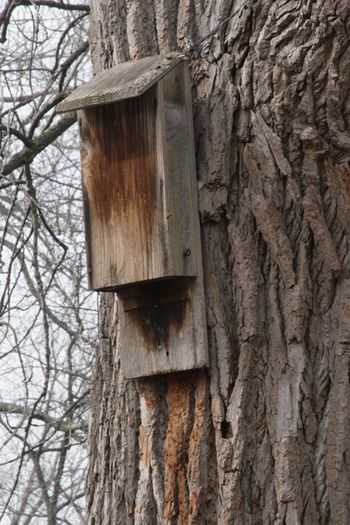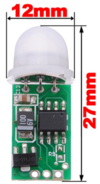LoraBatBox: Difference between revisions
No edit summary |
No edit summary |
||
| Line 28: | Line 28: | ||
Sleeping bats will likely not trigger the movement detection, but that's OK I think, knowing when they enter or leave the bat box is probably enough info. | Sleeping bats will likely not trigger the movement detection, but that's OK I think, knowing when they enter or leave the bat box is probably enough info. | ||
[[File:ttn.png|right|100px]] | |||
=== LoRa / The-Things-Network === | === LoRa / The-Things-Network === | ||
I think the LoRa radio technology is perfectly suited as a transmission medium for sending the bat box occupancy data. | I think the LoRa radio technology is perfectly suited as a transmission medium for sending the bat box occupancy data. | ||
Revision as of 19:59, 27 February 2017
| Project LoraBatBox | |
|---|---|

| |
| Monitoring bat boxes with LoRa | |
| Status | Initializing |
| Contact | bertrik |
| Last Update | 2017-02-27 |
This page is an idea for adding LoRa capability to a bat box.
A popular kind of bat box is a flat wooden box with an opening on the bottom and mounted to a tree trunk or building. Bats can use these to sleep during the day (they hunt at night for insects). Some kinds of bats can even use a bat box to raise their young.
To check if a bat box is in use by bats, you can walk up to the box during the day and shine a light into it to see if there are any bats there. But I think it would be nice to investigate if this can be done automatically, without disturbing them with a light!
Introduction
The basic idea is to mount some piece of electronics in or on the bat box that monitors if there are any bats in there. Periodically (say once a day), the presence of bats is broadcast using a LoRa (long range) radio transmitter to a central place (e.g. the internet).
Design choices
PIR movement detection
To sense the presence of bats inside the bat box, I plan to use a PIR (passive infrared) detector module which can detect movement of warm bodies. A PIR typically has a low current requirement (say 70 uA), so it can probably be turned on most of the time. Sleeping bats will likely not trigger the movement detection, but that's OK I think, knowing when they enter or leave the bat box is probably enough info.
LoRa / The-Things-Network
I think the LoRa radio technology is perfectly suited as a transmission medium for sending the bat box occupancy data. LoRa has a larger range than similar radio technologies, has relative immunity to narrow-band interference and allows for low-power transmissions. There are already several LoRa gateways provided by the-things-network (TTN) that can receive and forward the data for free (no subscription needed, fair-use policy). If the LoRa network is down for some reason, no harm is done to the bats, possibly just a few days worth of data lost, and I think I can come up with a solution to that.
STM32 low-power microcontroller
As the main processor, I plan to use an STM32 processor board:
- already voltage compatible (3.3V) with an RFM95 LoRa transceiver
- low-cost, processor board can be found for about E2,- each
- apparently has good low-power performance and sleep modes
- has a 32 kHz crystal on board, so it can run a real-time-clock (RTC)
LiFePO4 Battery
To power the electronics, I plan to use a LiFePO4 battery. A battery of this type has a voltage of around 3.2V, so it is capable of running the electronics directly, without a voltage regulator. It also has a quite large capacity (mAh per gram) and is relatively safe (doesn't catch fire easily, unlike some other lithium battery types).
Operation
The basic idea is to indicate whether movement was detected within intervals of 15 minutes. So each day the electronics see 96 such intervals (24 hours, 4 intervals per hour). Encoded using 1 bit per interval, we can send the result of one day in just 12 bytes (excluding overhead from the LoRaWAN protocol, about 13 bytes and our own overhead, e.g. a time stamp).
If movement is detected by the PIR, the processor is woken up, it notes the movement in internal memory and turns off the PIR so it can sleep for the remainder of the 15 minute interval. This way, we conserve the maximum amount of energy in the battery and make it last as long as possible. (idea: use a solar panel to recharge).
Once a day, at some random time, the bat box sends all the data collected so far to the network application connected to the TTN.
time synchronisation algorithm
To do all of this, the LoraBatBox needs to know the time of course. To keep the time, we can use the (RTC) onboard the STM32 processor. I plan to synchronize the time using the following algorithm:
- in every "up-link" transmission from the bat box to the network, there is a field containing the UTC time (seconds since 1970/1/1) from the point of view of the bat box
- upon reception (a few seconds later), the network application compares the time field sent by the bat box with the actual time
- if the difference is beyond some threshold (say 2 minutes), it prepares a down-link transmission with the required offset to correct the time
- when the bat box receives the down-link transmission, it updates its clock with the correction offset.
So, for example if a bat box powers up with no knowledge of the time at all, it'll start at UTC time 0. The network application will note a huge time error and prepare a down-link message with the correct offset. When the bat box receives the down-link message, it applies the offset to its clock and so updates itself to the correct time. It doesn't really matter how much time there is between an up-link and a down-link or when the down-link message is scheduled exactly, since the network sends a time *difference*, not an absolute time. Down-link messages are only sent when there is a large time error, so they should be relatively infrequent. This reduces the network load on the TTN.
redundant data transfer
It is a bit premature to think about this, but I'm considering to add some redundancy. For example we could send the data of today + yesterday each day, so if somehow the TTN is down for a day / the battery is low, we can miss a transmission and still have complete data. This doubles the amount of data to be sent.
Another way would be some kind of logarithmic storage:
- send data accumulated per 3 hours in the past day (8 bits)
- send data accumulated per day in the past 8 days (8 bits)
- send data accumulated per week of the past 8 weeks (8 bits)
- send data acucumulated per month of the past 8 months (8 bits)
This adds only 4 bytes to the message, but gives a nice historical overview in each single message.
Links
Future ideas
Challenges and ideas to be implemented in the future:
- port the arduino lmic stack to the STM32 processor:
- the current code uses a call to fdev_setup to bind printf-like debug statements to the serial port. This doesn't appear to exist in the STM32 arduino libraries, I'm working adding this to STM32 too
- make the radio interface work over SPI, I'm confident this can work
- find some way to keep the electronics safe from weather, e.g. wrap it all in a kind of silicone pouch
- consider adding some kind of test signal, to verify the behaviour of the PIR, perhaps light a bulb once a day for a few seconds?
- measure other properties of the bat box, like battery state (voltage), temperature and relative humidity. Once the whole data chain is set up, this should be easy.
- create a nice user front-end that shows the received data in easy to understand map
- add a solar panel to recharge the battery



